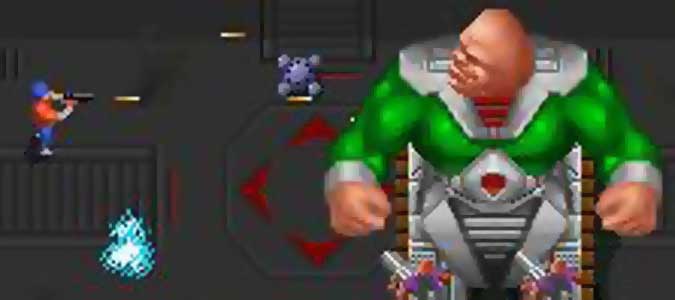This page may contain one or more affiliate links, which means that if you purchase a product through that link, I may receive compensation. The links will be identified with the text "affiliate link". Click to learn more.
As a young child, I encountered a game with an outrageous premise that proved incredibly entertaining. The Smash TV video game for the Super Nintendo, adapted from the arcade classic, placed players in a twisted game show battle rooms where the objective was to shoot attackers and eliminate endless enemy waves while an enthusiastic studio audience cheered. The rewards for this carnage included massive amounts of money, luxury vehicles, and cutting-edge electronics like VCRs.
Developed by Williams Electronics Games and designed by Mark Turmell, the Smash TV arcade cabinet became a staple in coin-op games of its era. The game’s concept of a dystopian television game show where contestants fight for survival would influence many future titles.
The combination of pulsing game show music synchronized with intense combat creates an unmatched gaming experience. Smash TV essentially delivers a supercharged version of a zombie apocalypse. While the television announcer’s commentary and arcade-style soundtrack contribute significantly to the atmosphere, the real challenge comes from the gameplay itself, which ranks among the most difficult in gaming history.
Players face relentless waves of adversaries wielding various weapons – from basic melee weapons to advanced firearms, energy weapons, and explosives. The sheer number of simultaneous attackers makes survival a constant struggle. As an arcade game, it was deliberately designed to be punishingly difficult to encourage continued quarter insertion. The arcade version featured an innovative dual-joystick control scheme: one for movement and another for shooting. This twin-stick shooter setup, though unconventional, proved highly effective for maintaining constant firepower while navigating through the chaos.
The game draws clear inspiration from popular media. The Master of Ceremonies’ catchphrase “I’d buy that for a dollar” directly references the film Robocop. The central premise of a lethal game show where contestants compete for prizes closely mirrors the plot of The Running Man, both the Stephen King novel and its film adaptation.
Legacy in Gaming
Before Midway’s eventual decline, they would achieve massive success with the Mortal Kombat franchise in 1999. Smash TV predated Mortal Kombat by several years, suggesting that the extreme violence that became Midway’s trademark may have originated with Smash TV’s intense combat. The game’s influence extended well into the future, with titles like Total Carnage in 1999 building on its foundation.
The most widely recognized versions of the game were its home console ports. Both the Super Nintendo and Sega Genesis adaptations successfully captured the essence of the arcade original, providing solid gameplay experiences for home audiences. The game was also ported to other platforms, including the Nintendo Entertainment System (NES), Master System and Game Gear, expanding its reach to a broader audience. The NES version was a surprise due to its limited amount of buttons and graphics.
Smash TV helped establish several gaming conventions that would influence future titles. The twin-stick shooting mechanic would later become standard in many modern games. The game’s blend of violence and satire of consumer culture resonated with players and critics alike. Its legacy lives on through collections like Midway Arcade Treasures and its release on Xbox Live Arcade, introducing new generations to this classic multidirectional shooter.
The home console versions managed to recreate the arcade experience remarkably well, despite hardware limitations. Both the Super Nintendo and Genesis versions maintained smooth performance even during intense combat sequences with numerous on-screen enemies.
Enduring Appeal
The game’s unique combination of challenging gameplay, satirical elements, boss battles, and non-stop action has helped it maintain a dedicated following. Modern gamers continue to discover and appreciate Smash TV through various gaming platforms and emulation.
The game show framework adds an extra layer of entertainment to the experience. Between combat rounds, players can choose different paths leading to various prizes, creating an element of strategy amid the chaos. The announcer’s commentary provides both guidance and humor throughout the experience, enhancing the feeling of participating in a twisted television spectacle.
The shooting mechanics require precise control and strategic thinking. Players must manage their position while maintaining constant fire in different directions. Power-ups and weapon upgrades appear regularly, adding variety to the combat experience. The ability to collect money and valuable prizes during frantic firefights adds to the game’s unique appeal.
Each arena presents unique challenges and hazards. The game progressively introduces new enemy types and environmental obstacles, keeping players engaged through increasingly difficult scenarios. The multi-room structure provides brief moments of respite between intense combat sequences. The game culminates in the legendary Pleasure Dome, a final challenge that pushes players to their limits.
Style
The game’s graphics effectively convey both the game show atmosphere and the intense action. Enemy designs range from basic thugs to more elaborate mechanical opponents. The visual effects for weapons and explosions add to the spectacle without overwhelming the screen, maintaining clarity in the single-screen arenas.
The soundtrack combines upbeat game show music with intense action themes. Sound effects provide crucial feedback during combat, helping players track incoming threats and power-ups. The Master of Ceremonies’ voice work adds personality and helps establish the game’s unique tone, with catchphrases like “Big money! Big prizes! I love it!” becoming instantly recognizable.
Released during a period when arcade games were transitioning to home consoles, Smash TV demonstrated how arcade experiences could be successfully adapted for home play. The game’s influence can be seen in numerous subsequent titles that combined intense action with satirical elements, cementing its place in video game history. Unfortunately, games like Smash TV just aren’t around anymore, since the idea of blind violence and testosterone-fueled murder are now days of the past.

